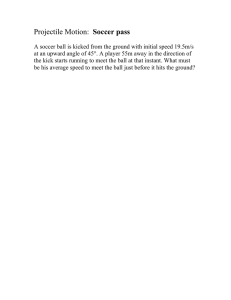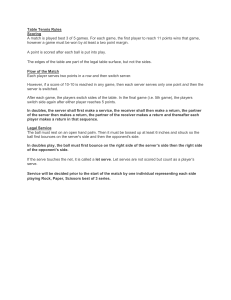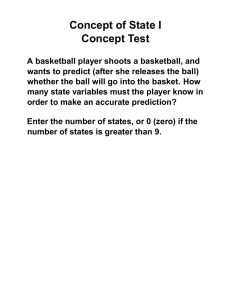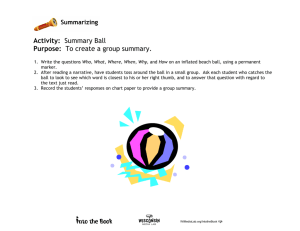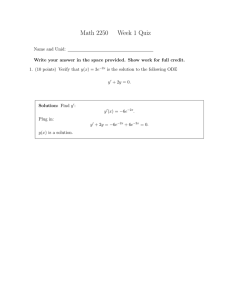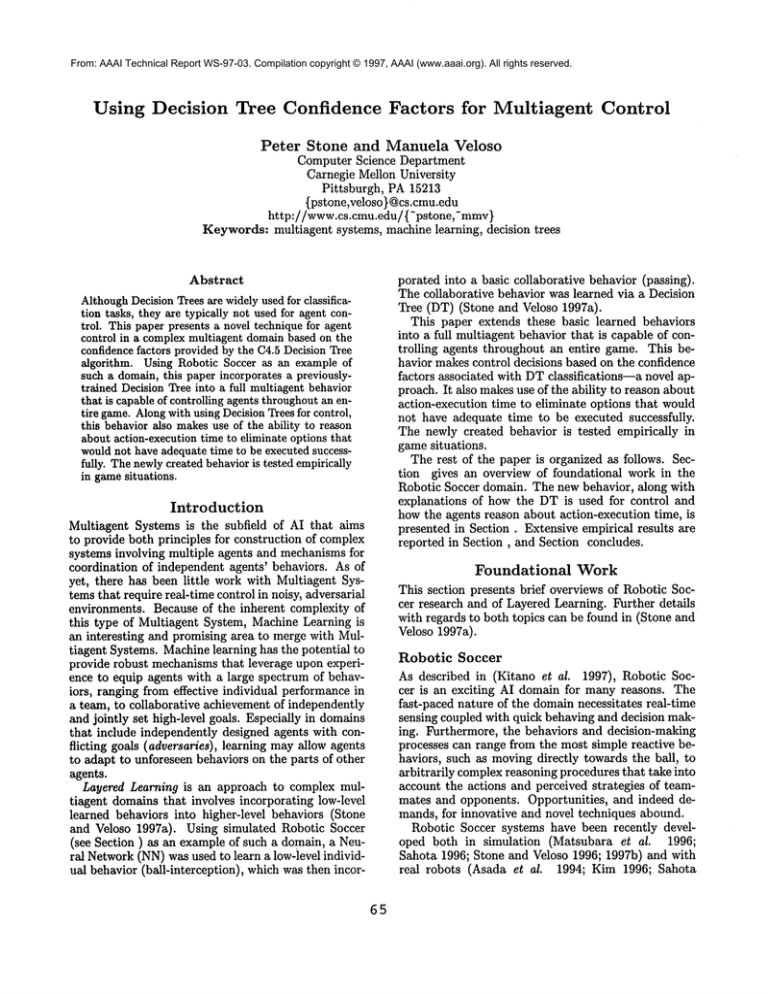
From: AAAI Technical Report WS-97-03. Compilation copyright © 1997, AAAI (www.aaai.org). All rights reserved.
Using Decision
Tree Confidence
Factors
for Multiagent
Control
Peter
Stone
and Manuela
Veloso
Computer Science Department
Carnegie Mellon University
Pittsburgh, PA 15213
{pstone,veloso}@cs.cmu.edu
http://www.cs.cmu.edu/{
~pstone,-mmv}
Keywords:multiagent systems, machine learning, decision trees
porated into a basic collaborative behavior (passing).
The collaborative behavior was learned via a Decision
Tree (DT) (Stone and Veloso 1997a).
This paper extends these basic learned behaviors
into a full multiagent behavior that is capable of controlling agents throughout an entire game. This behavior makes control decisions based on the confidence
factors associated with DTclassifications--a novel approach. It also makesuse of the ability to reason about
action-execution time to eliminate options that would
not have adequate time to be executed successfully.
The newly created behavior is tested empirically in
game situations.
The rest of the paper is organized as follows. Section gives an overview of foundational work in the
Robotic Soccer domain. The new behavior, along with
explanations of how the DT is used for control and
how the agents reason about action-execution time, is
presented in Section. Extensive empirical results are
reported in Section, and Section concludes.
Abstract
AlthoughDecisionTrees are widely used for classification tasks, they are typically not used for agent control. This paperpresents a novel technique for agent
control in a complexmultiagent domainbased on the
confidencefactors provided by the C4.5 Decision Tree
algorithm. Using Robotic Soccer as an example of
such a domain, this paper incorporates a previouslytrained Decision Tree into a full multiagent behavior
that is capableof controlling agents throughoutan entire game.Alongwith using Decision Trees for control,
this behavior also makesuse of the ability to reason
about action-execution time to eliminate options that
wouldnot have adequate time to be executed successfully. The newlycreated behavioris tested empirically
in gamesituations.
Introduction
Multiagent Systems is the subfield of AI that aims
to provide both principles for construction of complex
systems involving multiple agents and mechanisms for
coordination of independent agents’ behaviors. As of
yet, there has been little work with Multiagent Systems that require real-time control in noisy, adversarial
environments. Because of the inherent complexity of
this type of Multiagent System, Machine Learning is
an interesting and promising area to merge with Multiagent Systems. Machinelearning has the potential to
provide robust mechanisms that leverage upon experience to equip agents with a large spectrum of behaviors, ranging from effective individual performance in
a team, to collaborative achievement of independently
and jointly set high-level goals. Especially in domains
that include independently designed agents with conflicting goals (adversaries), learning mayallow agents
to adapt to unforeseen behaviors on the parts of other
agents.
Layered Learning is an approach to complex multiagent domains that involves incorporating low-level
learned behaviors into higher-level behaviors (Stone
and Veloso 1997a). Using simulated Robotic Soccer
(see Section ) as an example of such a domain, a Neural Network(NN) was used to learn a low-level individual behavior (ball-interception),
which was then incor-
Foundational
Work
This section presents brief overviews of Robotic Soccer research and of Layered Learning. Further details
with regards to both topics can be found in (Stone and
Veloso 1997a).
Robotic
Soccer
As described in (Kitano et al. 1997), Robotic Soccer is an exciting AI domain for many reasons. The
fast-paced nature of the domain necessitates real-time
sensing coupled with quick behaving and decision making. Furthermore, the behaviors and decision-making
processes can range from the most simple reactive behaviors, such as moving directly towards the ball, to
arbitrarily complexreasoning procedures that take into
account the actions and perceived strategies of teammates and opponents. Opportunities, and indeed demands, for innovative and novel techniques abound.
Robotic Soccer systems have been recently developed both in simulation (Matsubara et al. 1996;
Sahota 1996; Stone and Veloso 1996; 1997b) and with
real robots (Asada et al. 1994; Kim 1996; Sahota
65
et al. 1995; Sargent et al. 1997; Stone and Veloso
1997a). While robotic systems are difficult, expensive,
and time-consuming to use, they provide a certain degree of realism that is never possible in simulation.
On the other hand, simulators allow researchers to isolate key issues, implement complex behaviors, and run
many trials in a short amount of time. While much of
the past research has used Machine Learning in constrained situations, nobodyhas yet developed a full behavior based on learning techniques that can be used
successfully in a game situation.
The Soccer Server (Noda and Matsubara 1996),
which serves as the substrate system for the research
reported in this paper, captures enough real-world
complexities to be a very challenging domain. This
simulator is realistic in many ways: (i) the players’
vision is limited; (ii) the players can communicate
posting to a blackboard that is visible (but not necessarily intelligible) to all players; (iii) each player
controlled by a separate process; (iv) each team has
11 members; (v) players have limited stamina; (vi)
actuators and sensors are noisy; (vii) dynamics and
kinematics are modelled; and (viii) play occurs in real
time: the agents must react to their sensory inputs
at roughly the same speed as human or robotic soccer
players. The simulator, acting as a server, provides
a domain and supports users who wish to build their
ownagents (clients).
Layered
ment learning module, to learn whether or not to pass,
and to whom.
The successful combination of the learned NN and
DTdemonstrated the feasibility of the Layered Learning technique. However, the combined behavior was
trained and tested in a limited, artificial
situation
which does not reflect the full range of gamesituations.
In particular, a passer in a fixed position was trained to
identify whether a particular teammate could successfully receive a pass. Both the teammate and several
opponents were randomly placed within a restricted
range. They then used the trained NNto try to receive the pass.
Although the trained DT was empirically successful in the limited situation, it was unclear whether it
would generalize to the broader class of game situations. The work reported in this paper incorporates
the same trained DT into a complete behavior using
which players decide when to chase the ball, and after
reaching the ball, what to do with it.
First, a player movesto the ball-using the NN-when
it does not perceive any teammates who are likely to
reach it more quickly. Then, using a simple communication protocol, the player probes its teammates for
possible pass receivers (collaborators). Whena player
is going to use the DTto estimate the likelihood of a
pass succeeding, it alerts the teammate that the pass
is coming, and the teammate, in turn, sends some data
reflecting its view of the world back to the passer. The
DT algorithm used is C4.5 (Quinlan 1993), which automatically returns confidence factors along with classifications. These confidence factors are useful when
incorporating the DTinto a higher level behavior capable of controlling a client in gamesituations.
Learning
Layered Learning is a Multiagent Learning paradigm
designed to allow agents to learn to work together in
a real-time, noisy environment in the presence of both
teammates and adversaries. Layered Learning allows
for a bottom-up definition of agent capabilities at different levels in a complete multiagent domain. Machine Learning opportunities are identified when handcoding solutions are too complex to generate. Individual and collaborative behaviors in the presence of
adversaries are organized, learned, and combined in a
layered fashion.
To date, two levels of learned behaviors have been
implemented (Stone and Veloso 1997a). First, Soccer
Server clients used a Neural Network (NN) to learn
a low-level individual skill: how to intercept a moving ball. Then, using this learned skill, they learned
a higher-level, more "social," skill: one that involves
multiple players. The second skill, the ability to estimate the likelihood that a pass to a particular teammate will succeed, was learned using a Decision Tree
(DT). The DT was trained using C4.5 (Quinlan 1993)
under the assumption that the player receiving the
ball uses the trained NNwhen trying to receive the
pass. This technique of incorporating one learned behavior as part of another is an important component
of Layered Learning. As a further example, the output of the decision tree could be used as the input to a
higher-level learning module, for instance a reinforce-
Using the learned
behaviors
As described in Section , MLtechniques have been
studied in the Soccer Server in isolated situations.
However, the resulting behaviors have not yet been
tested in full game situations. In this paper, we examine the effectiveness in game situations of the DT
learned in (Stone and Veloso 1997a).
To our knowledge, this paper reports the first use
of DTsfor agent control. In particular, the confidence
factors that are returned along with classifications can
be used to differentiate
precisely among several options.
Receiver
Choice
Functions
Recall that the DTestimates the likelihood that a pass
to a specific player will succeed. Thus, for a client to
use the DTin a game, several additional aspects of its
behavior must be defined. First, the DT must be incorporated into a full Receiver Choice Function (RCF).
Wedefine the RCFto be the function that determines
what the client should do when it has possession of the
ball: whenthe ball is within kicking distance (2m). The
66
input of an RCFis the client’s perception of the current state of the world. The output is an action from
amongthe options dribble, kick, or pass, and a direction, either in terms of a player (i.e. towards teammate
number4) or in terms of a part of the field (i.e. towards
the goal). Consequently, before using the DT, the RCF
must choose a set of candidate receivers. Then, using
the output of the DTfor each of these receivers, the
RCFcan choose its receiver or else decide to dribble or
kick the ball. Table 1 defines three RCFs,one of which
uses the DT, and the others defined for the purposes
of comparison.
1. Each player has a set of receivers that it considers,
as indicated in Figure 1. The set of candidates is
determined by the player’s actual location on the
field, rather than its assigned position.
2. Anypotential receiver that is too close or too far
away (arbitrarily
chosen--but constant--bounds)
eliminated from consideration.
3. Any player that is out of position (because it was
chasing the ball) is eliminated from consideration.
4. IF there is an opponent nearby (arbitrarily chosen-but constant--bound) THENany potential receiver
that cannot be passed to immediately (the passer
wouldhave to circle around the ball first) is eliminated from consideration.
5. IF one or more potential receivers remain THEN
pass to the receiver as determined by the Receiver
Choice Function (RCF):
PRW (Prefer Right Wing): Use a fixed ordering on the
options. Players in the center prefer passing to
the right wing over the left.
RAND (Random): Choose randomly among the options.
DT (Decision Tree): Pass to the receiver to which
the trained decision tree (see Section ) assigns the
highest success confidence. If no confidence is
high enough, kick or dribble as indicated below.
6. ELSE(No potential receivers remain)
® IF there is an opponent nearby, THENkick the
ball forward;
¯ ELSEdribble the ball forward.
Table 1: Specification of the RCFs.
As indicated in Table 1, the set of candidate receivers
is determined by the players’ positions. Each player is
assigned a particular position on the field, or an area
to which it goes by default. The approximate locations
of these positions are indicated by the locations of the
players on the black team in Figure 1. The formation
used by all of the tested functions includes--from the
back (left)--a goalie, a sweeper, three defenders, three
midfielders, and three forwards. Whena player is near
its default position, it periodically announcesits posi-
67
°.I° ~o
Figure 1: Player positions used by the behaviors in this
paper. The black team, movingfrom left to right, has a
goalie, a sweeper, and one defender, midfielder, and forwardon the left, center, and right of the field. The arrows
emanatingfrom the players indicate the positions to which
each player considers passing when using the RCFs. The
players on the left of the field (top of the diagram)consider
symmetrical options to their counterparts on the right of
the field. The goalie has the sameoptions as the sweeper.
The white team has the same positions as the black, except
that it has no playerson its left side of the field, but rather
two in each position on its right.
tion to teammates; when a player leaves its position to
chase the ball, it announces this fact and is no longer
considered "in position" (see Table 1, Step 3). The arrows emanating from the players in Figure 1 indicate
the positions to which each player considers passing.
The clients determine which players are in which positions by listening to their teammates’ announcements.
The RCFs defined and used by this paper are laid
out in Table 1. As suggested by its name, the DT-Decision Tree--RCF uses the DT described in Section
to choose from amongthe candidate receivers. In particular, as long as one of the receivers’ success confidences is positive, the DT RCFindicates that the
passer should pass to the receiver with the highest success confidence, breaking ties randomly. If no receiver
has a positive success confidence, the player with the
ball should dribble or kick the ball forwards (towards
the opponent goal or towards one of the forward corners). This use of the DTconfidence factor is, to our
knowledge, a novel approach to agent control. The
RAND--Random--RCF is the same as the DT RCF
except that it chooses randomly from among the candidate receivers.
The PRW--Prefer Right Wing--RCF uses a fixed
ordering on the candidate receivers for each of the positions on the field. In general, defenders prefer to pass
to the wings rather than forward, midfielders prefer to
pass forward rather than sideways, and forwards tend
to shoot. As indicated by the name, all players in the
center of the field prefer passing to the right rather
than passing to the left. The RCFsimply returns the
most preferable candidate receiver according to this
fixed ordering. Again, if no receivers are eligible, the
RCFreturns "dribble" or "kick." This RCFwas the
initial hand-coded behavior for use in games.
Reasoning
about
action
execution
1. IF the client doesn’t know where the ball is, THEN
turn until finding it.
2. IF the ball is more than 10m away ANDa teammate is closer to the ball than the client is, THEN:
¯ IF the ball is coming towards the client, THEN
watch the ball;
¯ ELSEMove randomly near client position.
time
An important thing to notice in the RCFdefinition
(Table 1) is that the clients can reason about howlong
they predict they have to act. In particular, if there is
an opponent nearby, there is a danger of losing the ball
before being able to pass or shoot it. In this situation,
it is to the passer’s advantage to get rid of the ball as
quickly as possible.
This priority is manifested in the RCFsin two ways:
(i) in Step 4 of Table 1, teammates to whomthe client
cannot pass immediately are eliminated from consideration; and (ii) in Step 6, the client kicks the ball away
(or shoots) rather than dribbling. Whena player is between the ball and the teammate to which it wants to
pass, it must moveout of the bali’s path before passing. Since this action takes time, an opponent often
has the opportunity to get to the ball before it can be
successfully released. Thus, in Step 4, when there is
an opponent nearby the RCFsonly consider passing to
players to whomthe client can pass immediately. The
concept of nearby could be the learned class of positions
from which the opponent could steal the ball. For the
purposes of this paper, "within 10m"is an empirically
acceptable approximation.
Similarly, the point of dribbling the ball (kicking the
ball a small amount in a certain direction and staying
with it) is to keepthe ball for a little longer until a good
pass becomesavailable or until the player is in a good
position to shoot. However, if there is an opponent
nearby, dribbling often allows the opponent time to
get to the ball. In this situation, as indicated in Step 6
of Table 1, the player should kick the ball forward (or
shoot) rather than dribbling.
The ability to reason about how muchtime is available for action is an important componentof the RCFs
and contributes significantly to their success in game
situations (see Section ).
Incorporating
the
RCF in
3. ELSE:(client is the closest to the ball, or the ball is
within lore)
¯ IF The ball is too far away to kick (> 2m), THEN
moveto the ball, using the trained Neural Network
when appropriate;
¯ ELSEPass, Dribble, or Kick the ball as indicated
by the Receiver Choice Function (RCF).
Table 2: The complete behavior used by the clients in
gamesituations.
seen the ball, it assumes that it no longer knowswhere
the ball is (Bowlinget al. 1996).
Once the ball has been located, the client can execute its behavior. As described in Section, each player
is assigned a particular position on the field. Unless
chasing the ball, the client goes to its position, moving
around randomly within a small range of the position.
The player represents its position as x,y coordinates
on the field.
The client chases the ball whenever it thinks that
it is the closest team-memberto the ball. Notice that
it may not actually be the closest player to the ball
if some of its teammates are too far away to see, and
if they have not announced their positions recently.
However, if a player mistakenly thinks that it is the
closest player, it will get part of the way to the ball,
notice that another teammate is closer, and then turn
back to its position. Whenthe ball is within a certain
small range (arbitrarily 10m), the client always goes
towards the ball. Whenthe ball is moving towards the
client or when a teammate has indicated an intention
to pass in its direction, the client watches the ball to
see if either of the two above conditions is met. As
required for use of the DT, every player is equipped
with the trained Neural Network (see Section ) which
can be used to help intercept the ball.
Finally,
every team member uses the same RCF.
Wheneverthe ball is within kicking distance, the client
calls its RCFto decide whether to dribble, kick, or
pass, and to where. The behavior incorporating the
RCFsis laid out in Table 2.
a behavior
In Section, the method of using a DTas a part of an
RCFis described in detail. However, the RCFis itself
not a complete client behavior: it only applies when
the ball is within kicking distance. This section situates the RCFs within a complete behavior that can
then be used throughout the course of a game. The
player’s first priority is alwaysto find the bail’s location (only objects in front of the player are seen).
it doesn’t knowwhere the ball is, it turns until the
ball is in view. Whenturning away from the ball, it
remembers the ball’s location for a short amount of
time; however after about three seconds, if it hasn’t
Experiments
In this section we present the results of empirically
testing how the complete behavior performs when using the different RCFoptions. Since the behaviors
differ only in their RCFs, we refer below to, for ex68
ample, "the complete behavior with the DT RCF"
simply as "the DT RCF." Also presented are empirical results verifying the advantage of reasoning about
action-execution time.
In order to test the different RCFs, we created a
team formation that emphasizes the advantage of passing to some teammates over others. Whenboth teams
use the standard formation (that of the black team in
Figure 1), every player is covered by one opponent.
However,this situation is an artificial artifact of having the same person program both teams. Ideally, the
players would have the ability to move to open positions on the field. Howeverat this point, such functionality represents future work (see Section ). Instead,
order to reflect the fact that someplayers are typically
more open than others, we tested the RCFs against
the OPR--Only Play Right--formation which is illustrated by the white team in Figure 1. Wealso used
the symmetrical OPL-Only Play Left--formation for
testing. These behaviors are specified in Table 3.
50
Running
GoalDifferencevs. Game
Number
40-PRW
(vs. OPR)DT
........
(vs.OPL)
......... ~/
30 ¯ PRW
2O
RAN~/~
lo
o................
"%" ""
~10
"%"-"........ "’"’X .....
X.,........
-20
0
’
5
’
10
’
’
’
15
20
25
GameNumber
,
30
35
Figure 2: The differences in cumulative goals as the runs
progress.
15
Running
Victory Differencevs. Game
Number
DT-PRW
(vs. OPR)
........
10 ’ PRW(vs. OPL).........
® The opponent behaviors are exactly the same as the
RAND
behavior except that the players are assigned
to different positions:
5
OPR(Only Play Right): As illustrated
by the white
team in Figure 1, two players are at each position
on the right side of the field, with no players on
the left side of the field.
OPL(Only Play Left): Same as above, except all
the players are on the left side of the field.
^
^
~ v ~ ~ "~
RAN D/~-"~__~
0
....
...............
\::----% ........
/ / ..... ~//~,
-5
-10
0
Table 3: OPRand OPLbehavior specification.
During testing, each run consists of 34 five-minute
games between a pair of teams. Wetabulate the cumulative score both in total goals and in games won
(ties are not broken) as in Table 4. Graphs record the
difference in cumulative goals scored (Figure 2) and
games won (Figure 3) as the run progresses.
5
....
10
’
15
20
25
GameNumber
30
35
Figure 3: The differences in cumulative gameswonas the
runs progress.
RCF (vs. OPR) Games (W - L) Overall Score
DT
19 - 9
135 - 97
104 - 105
PRW
11 - 14
114 - 128
PRW (vs. OPL)
8- 16
14- 12
115 - 111
RAND
Table 4: Results are cumulative over 34 five-minute
games:ties are not broken. Unless otherwise indicated,
the opponent--whosescore always appears second--uses
the OPRformation.
In order to test the effectiveness of the DT RCF,
we compared its performance against the performance
of the PRWand RANDRCFs when facing the same
opponent: OPR. While the DT and RANDRCFs are
symmetrical in their decision making, the PRWRCF
gives preference to one side of the field and therefore
has an advantage against the OPRstrategy. Thus we
69
also include the results of the PRWRCFwhen it faces
the symmetrical opponent: OPL. From the table and
the graphs, it is apparent that the DT RCFis an effective method of decision making in this domain.
In order to test the effectiveness of the reasoning
about action-execution time, we compared the performance of the standard DT RCFagainst that of the
same RCFwith the assumption that there is never an
opponent nearby: even if there is, the RCFignores
it. This assumption affects Steps 4 and 6 of the RCF
specification in Table 1. Both RCFsare played against
the OPRbehavior. As apparent from Table 5, the reasoning about action-execution time makes a significant
difference.
We expect that the DT RCF, including the reasoning about action-execution time, will perform favorably against teams that cover our players unevenly so
that the DT can find an open player to whomto pass.
Indeed, it is able to defeat a hard-wired multiagent
behavior coded by Sekine (Sekine 1996).
RCF (vs. OPR) Games (W - L) Overall Score
Standard DT
19 - 9
135 - 97
No-rush DT
13 - 16
91 - 108
Table 5: No-rush DTis the same RCFas the standard DT
except that there is no reasoning about action-execution
time. The Standard DTRCFperforms significantly better.
Discussion
References
M. Asada, E. Uchibe, S. Noda, S. Tawaratsumida, and
K. Hosoda. Coordination of multiple behaviors acquired by vision-based reinforcement learning. In Proc.
of IEEE/RSJ/GIInternational Conference on Intelligent
Robots and Systems 1995 (IROS ’9~), pages 917-924,
1994.
Mike Bowling, Peter Stone, and ManuelaVeloso. Predictive memoryfor an inaccessible environment. In Proceedings of the IROS-96 Workshop on RoboCup, November
1996.
Jong-HwanKim, editor. Proceedings of the Micro-Robot
World Cup Soccer Tournament, Taejon, Korea, November
1996.
Hiroaki Kitano, Yasuo Kuniyoshi, Itsuki Noda, Minoru
Asada, Hitoshi Matsubara, and Ei-Ichi Osawa. Robocup:
A challenge problem for ai. AI Magazine, 18(1):73-85,
Spring 1997.
Hitoshi Matsubara, Itsuki Noda, and Kazuo Hiraki.
Learning of cooperative actions in multi-agent systems:
a case study of pass play in soccer. In Adaptation, Coevolution and Learning in Multiagent Systems: Papers from
the 1996 AAAI Spring Symposium, pages 63-67, Menlo
Park,CA, March 1996. AAAIPress. AAAITechnical Report SS-96-01.
Itsuki Noda and Hitoshi Matsubara. Soccer server and
researches on multi-agent systems. In Proceedingsof the
IROS-96 Workshop on RoboCup, November1996.
J. Ross Quinlan. C~.5: Programsfor MachineLearning.
Morgan Kaufmann, San Mateo, CA, 1993.
Michael K. Sahota, Alan K. Mackworth, Rod A. Barman, and Stewart J. Kingdom Real-time control of
soccer-playing robots using off-board vision: the dynamite
testbed. In IEEE International Conference on Systems,
Man,and Cybernetics, pages 3690-3663, 1995.
Michael Sahota. Dynasim user guide. Available at
http://www.cs.ubc.ca/nest/lci/soccer, January 1996.
RandySargent, Bill Bailey, Carl Witty, and AnneWright.
Dynamicobject capture using fast vision tracking. AI
Magazine,18(1):65-72, Spring 1997.
YoshikazuSekine, 1996. Soccer Server client available at
http://ci.etl.go.jp/noda/soccer/client.html.
Peter Stone and ManuelaVeloso. Beating a defender in
robotic soccer: Memory-basedlearning of a continuous
function. In David S. Touretzky, Michael C. Mozer, and
MichaelE. Hasselmo,editors, Advancesin Neural Information Processing Systems 8, pages 896-902, Cambridge,
MA,1996. MITpress.
Peter Stone and ManuelaVeloso. A layered approach to
learning client behaviors in the robocupsoccer server. To
appear in Applied Artificial Intelligence (AAI) Journal,
1997.
Peter Stone and Manuela M. Veloso. Towards collaborative and adversarial learning: A case study in robotic
soccer. To appear in International Journal of HumanComputerSystems (IJHCS), 1997.
and Conclusion
The experiments reported Section indicate that the
confidence factors provided by standard DT software
can be used for effective agent control. Combinedwith
some basic reasoning about the action-execution times
of different options--necessitated by the real-time nature of this domain, the DT-basedcontrol function outperformed both random and hand-coded alternatives.
Even though the DTwas trained in a limited artificial
situation, it was useful for agent control in a broader
scenario.
Throughout this paper, the multiagent behaviors are
tested against an opponent that leaves one side of the
field free, while covering the other side heavily. This
opponent simulates a situation in which the players
without the ball make an effort to moveto an open position on the field. Such collaborative reasoning has not
yet been implemented in the Soccer Server. However,
the fact that the DT is able to exploit open players
indicates that reasoning about field positioning when
a teammate has the ball would be a useful next step
in the development of learned collaborative behaviors.
Along with more variable field positioning, there is
still a great deal of future work to be done in this domain. First, one could build additional learned layers on top of the NNand DTlayers described in Section . The behavior used in this paper uses the DT
as a part of a hand-coded high-level multiagent behavior. However, several parameters are arbitrarily
chosen. A behavior that learns how to map the classifications and confidence factors of the DTto passing/dribbling/shooting decisions may perform better.
Second, on-line adversarial learning methods that can
adapt to opponent behaviors during the course of a
game may be more successful against a broad range of
opponents than current methods.
Nevertheless, the incorporation of low-level learning
modules into a full multiagent behavior that can be
used in gamesituations is a significant advance towards
intelligent multiagent behaviors in a complexreal-time
domain. Furthermore, the ability to reason about the
amountof time available to act is essential in domains
with continuously changing state. Finally, as DTconfidence factors are effective tools in this domain, they are
a new potentially useful tool for agent control in general. These contributions promise an exciting future
for learning-based methods in real-time, adversarial,
multiagent domains.
7O

